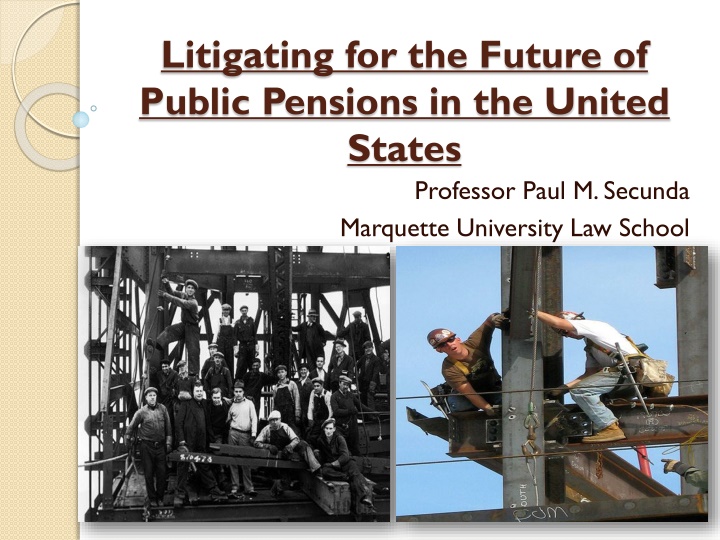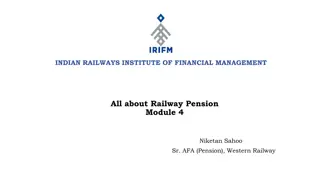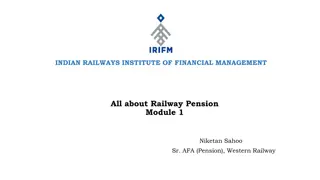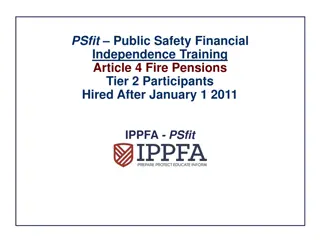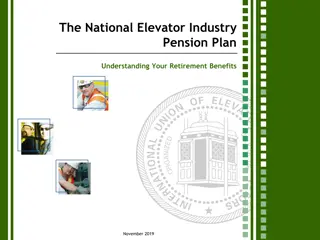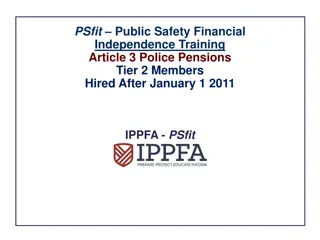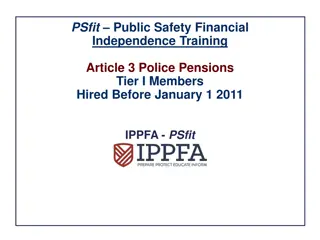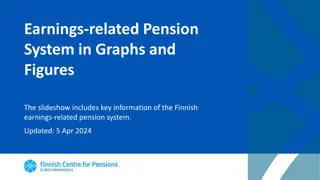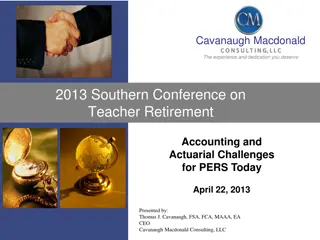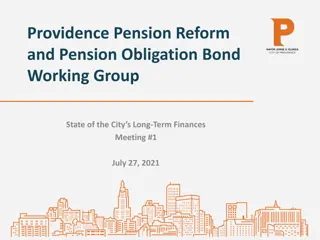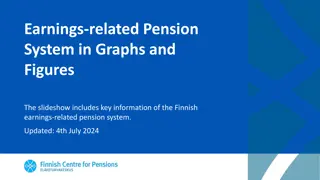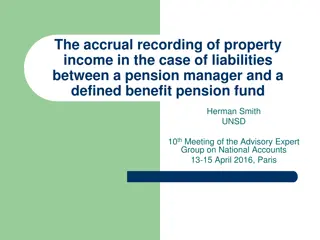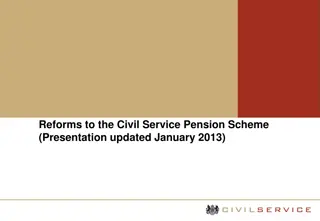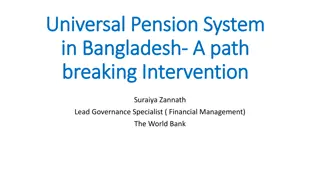Public Pension Systems in the United States
Explore the differences between private and public sector pension systems in the United States. While private sector plans are regulated by ERISA, government pension plans have more freedom in design and structure. The overview includes insights on defined contribution and defined benefit plans, federal, state, and local pension issues, and recent changes in the federal pension system.
Uploaded on Sep 30, 2024 | 0 Views
Download Presentation

Please find below an Image/Link to download the presentation.
The content on the website is provided AS IS for your information and personal use only. It may not be sold, licensed, or shared on other websites without obtaining consent from the author.If you encounter any issues during the download, it is possible that the publisher has removed the file from their server.
You are allowed to download the files provided on this website for personal or commercial use, subject to the condition that they are used lawfully. All files are the property of their respective owners.
The content on the website is provided AS IS for your information and personal use only. It may not be sold, licensed, or shared on other websites without obtaining consent from the author.
E N D
Presentation Transcript
Litigating for the Future of Public Pensions in the United States Professor Paul M. Secunda Marquette University Law School
Overview of American Employer- Sponsored Pension System ERISA: Employee Retiree Income Security Act of 1974 Statutory Scheme for Private Sector Retirement Plans Does Not Apply to Government Plans
Overview of American Employer- Sponsored Pension System A pension plan subject to ERISA must design, structure, and fund its plan in accordance with federal rules whereas public pension plans are largely free to structure their pension plans as they see fit and are not subject to any funding requirements other than what state law might impose. Amy Monahan & Renita Thrukal (2013)
Overview of American Employer- Sponsored Pension System Defined Contribution Plans Places all investment- related risk for retirement on the employee. Defined Benefit Plans Burden is on the employer to contribute funds to the plan to ensure the plan is fully funded. Public Sector Employees Have MUCH Broader Access to DB Plans
Federal, State, and Local Pension issues exist at every level of the United States government. Federal Overview of System and Current Trends Involving Pension Reform State Madison Teachers Inc. v. Walker (WI) as an Example of Potential Challenges to Public Pension Reform Local Detroit Municipal Bankruptcy Case Study and the Partial Results of Chapter 9 Bankruptcy on Municipal Pensions
Federal Pension System: A Complex Structure Civil Service Retirement Act of 1920 (CSRA) Employees Hired Before 1984 Federal Employee s Retirement System Act of 1986 (FERS) Employees Hired After 1984 Thrift Savings Plan 401(k)-type Plan for FERS Employees Social Security Benefits For only FERS Employees
Federal Pension System: Recent Changes to Employee Contributions Funding Crisis: Civil Service Retirement and Disability Fund (CSRDF) (joint trust fund for federal defined benefit plans) 2011 - $761.5 billion unfunded actuarial liability Bipartisan Budget Act of 2013 Increased contribution rates of new employees from 0.8% (pre-2013 hires) or 3.1% (2013 hires) to 4.4% of income for new hires. Will these actions be taken further by Congressional action? Will litigation result?
State Pension Litigation Madison Teachers Inc. v. Walker Litigation that stems from Acts 10 and 32, 2011 labor and pension reforms in WI Issue: Can pension reforms require increased pension contributions from Milwaukee laborers?
State Pension Litigation Three Types of Claims Can Possibly Be Brought By Milwaukee Laborers: 1. Violation of Wisconsin Constitutional Home Rule Amendment II. Violation of the Contract Clause of the Wisconsin Constitution III. Violation of the Due Process or Takings Clause of the Wisconsin Constitution
State Pension Litigation The Home Rule Amendment Trial court found that reforms violated the Home Rule Amendment by interfering with Milwaukee s local affairs . The law was declared null and void under this argument. The Wisconsin Contract Clause Court applied a three-part test and found that the contracts clause barred applying the proposed reforms to City of Milwaukee workers.
State Pension Litigation: Three Part Contracts Clause Analysis 1. Was there a contractual impairment? Yes, the reforms impaired the city employees contractual rights to have the city pay their pension contributions. 2. Was the impairment substantial? Yes, the impairment was not foreseeable and therefore substantial. 3. Was the substantial impairment justified? No, rising costs to the city nor future effects to taxpayers permitted the contractual impairment.
State Pension Litigation The Wisconsin Due Process Clause The court found that there had not been a deprivation of a property interest without due process of law that was arbitrary or irrational Why did the plaintiffs in Madison Teachers not bring a takings clause claim? Rises and falls on contract clause analysis, so perhaps not worth brining as separate claim Case has been heard by the WI Supreme Court, in Nov. 2013, with a decision expected Summer 2014.
Local Pension Litigation: The Detroit Bankruptcy Litigation Detroit Filed for Bankruptcy in the Summer of 2013, the Largest Municipal Bankruptcy Filing in American History
Local Pension Litigation Main Issue To what degree could the bankruptcy court cut back on pension benefits owed to employees and retirees given specific provisions in the Michigan State Constitution providing protections against diminishment of pension rights?
Local Pension Litigation: Overview of American Bankruptcy Law Chapter 11 Pension claims receive some priority among creditors under a corporate reorganization. Chapter 9 Pension claims receive no priority (unsecured claims) under a Chapter 9 municipal bankruptcy code. Pension Claims That Enjoy a Priority Are Satisfied First Among the Various Creditor Claims and so Detroit City Employees Could Lose Substantial Pension Benefits
Local Pension Litigation: The Detroit Bankruptcy Litigation - Timeline Pre-Bankruptcy Filing City employees argued that Chapter 9 bankruptcy had to be stopped before it interfered with state constitutional rights. Initially a stay was ordered by MI state trial court, however, the state court of appeals stayed this decision. This allowed the Chapter 9 bankruptcy proceedings to proceed in bankruptcy court.
Local Pension Litigation: The Detroit Bankruptcy Litigation - Timeline Bankruptcy judge found that he had jurisdiction over all Detroit assets, including pension funds. Judge concluded that Michigan s constitution did not prevent pension obligations from being subject to bankruptcy process. Essentially means pension obligations were contractual in nature and subject to adjustment under the Bankruptcy Code. Controversial given nature of pensions as deferred compensation. Claims also received no priority under Chapter 9 treated as unsecured claims.
Local Pension Litigation: The Detroit Bankruptcy End Results Many employees and retirees have engaged in informal mediation with the city and have reached agreements. Awaiting a vote by city employees and retirees on the deal. Agreements must then be presented to the judge as part of approving the plan of adjustment for the bankruptcy. Other creditors may still gum up works.
Proposed Reforms: Federal Pension Plans Expanding ERISA Coverage to Federal Pension Plans 1. No federalism issues. 2. Provides another path to re-stabilize these pensions, without needing a taxpayer bailout. 3. Provides for minimum funding standards for federal pension plans.
Proposed Reforms: State and Local Pension Plans Construction of a New, More Comprehensive Uniform Public Pension Law for State and Local Pension Plans Require states to have one public pension system for the entire state. This provides economies of scales, more sophisticated investment advisors, etc. Pension plan must contain ERISA-like provisions. reporting and disclosure requirements, fiduciary requirements, remedial provisions, etc
Proposed Reforms: State and Local Pension Plans Model Law (cont d) Include specific provisions which ERISA does not have that specifically focus on the needs of public employees and employers. Social security issues Tax deduction issues Early retirement for police and firefighter issues
Conclusions There is a need to harmonize and standardize the hodge-podge of American public pension law. Enacting these proposed reforms will provide the necessary uniform standards which will help prevent public pension underfunding in the future. Thank you!
